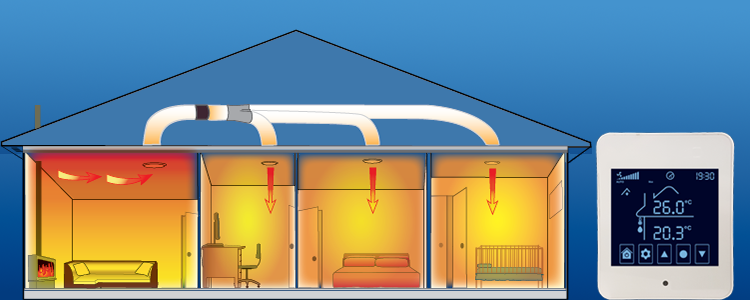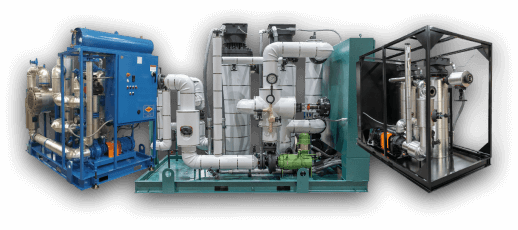Exploring the Potential of DVS Heat Transfer Systems in Next-Gen Thermal Management
Advancements in Heat Transfer Solutions: What You Required to Know for Optimum Performance
Advancements in Heat transfer systems are transforming efficiency throughout numerous sectors. Advanced products like graphene and nanofluids promise considerable improvements in thermal conductivity. On the other hand, the integration of IoT and device learning provides opportunities for real-time tracking and improved energy effectiveness. However, the landscape of thermal monitoring is swiftly developing (DVS Heat Transfer Systems). Understanding these developments is important for attaining perfect system efficiency and sustainability in the future. What specific advancements are forming this makeover?
Emerging Products for Improved Heat Transfer

Advanced Heat Exchanger Layouts
While standard Heat exchangers have offered their objective in numerous applications, progressed layouts are currently arising to fulfill the enhancing demands for performance and performance. These cutting-edge designs, such as plate, shell-and-tube, and finned-tube Heat exchangers, include enhanced surface and enhanced flow patterns to raise thermal transfer prices. Additionally, compact layouts enable minimized area demands without endangering efficiency. Advanced materials, such as composites and corrosion-resistant alloys, in addition enhance sturdiness and performance under severe problems. Simulation modern technologies and computational liquid dynamics are progressively utilized to refine these styles, ensuring peak Heat transfer attributes. As sectors seek to reduce energy consumption and optimize output, the adoption of advanced Heat exchanger designs is essential in attaining these goals.
The Role of Nanotechnology in Heat Transfer
Nanotechnology plays a vital function in boosting thermal conductivity within Heat transfer systems. By controling products at the nanoscale, scientists have attained considerable improvements in power efficiency. These innovations not just maximize efficiency however likewise add to even more sustainable power solutions.
Improved Thermal Conductivity
Considerable innovations in thermal conductivity have emerged through the application of nanotechnology, revolutionizing Heat transfer systems across various industries. By integrating nanoparticles right into Heat transfer fluids and materials, scientists have actually achieved exceptional rises in thermal conductivity. These nanoparticles, such as carbon nanotubes, graphene, and metal oxides, enhance the Heat transfer homes due to their high surface and special thermal characteristics. The resulting composites exhibit improved performance in applications ranging from electronic devices cooling down systems to renewable resource innovations. The ability to customize the size, form, and composition of nanoparticles allows for enhanced thermal administration services. Therefore, nanotechnology remains to play a critical role in the development of more efficient and effective Heat transfer systems, leading the way for enhanced industrial applications.
Power Performance Improvements

Combination of IoT in Heat Transfer Systems
The assimilation of IoT in Heat transfer systems introduces the application of smart sensing units that improve operational effectiveness. These sensing units allow real-time information monitoring, enabling prompt adjustments and optimizations. This technological development has the potential to substantially enhance performance and power management in Heat transfer applications.
Smart Sensors Implementation
As Heat transfer systems advance, the integration of wise sensors with the Internet of Things (IoT) has actually emerged as a transformative method. These sensors make it possible for real-time monitoring of circulation, temperature level, and stress prices, boosting system effectiveness and dependability. By gathering and transferring information, they promote positive upkeep, reducing the danger of system failings. Furthermore, wise sensing units add to power cost savings by refining operational criteria based on environmental problems. Their capability to examine anomalies and trends enables informed decision-making, making sure peak performance of Heat transfer systems. As markets increasingly adopt this technology, the implementation of smart sensing units stands to change just how Heat transfer systems are handled, leading the way for higher sustainability and improved performance results.
Real-Time Data Monitoring
Exactly how can real-time information monitoring improve the performance of Heat transfer systems? By integrating Net of Points (IoT) innovation, Heat transfer systems can leverage continuous data collection from smart sensors. This real-time monitoring enables immediate evaluation of circulation, stress, and temperature rates, enabling operators to recognize ineffectiveness promptly. Modifications can be made to maximize performance, reduce power usage, and extend equipment life-span. Furthermore, anticipating maintenance can be carried out, minimizing unanticipated downtime and costly repair work. The capacity to picture performance metrics with control panels enhances decision-making, promoting an aggressive approach to system administration. Eventually, real-time information monitoring not only enhances operational effectiveness yet additionally adds to sustainability goals within industrial processes.
Energy Performance and Sustainability Trends
Power effectiveness and sustainability fads are improving the landscape of Heat transfer systems, driving development and compliance throughout numerous sectors. Organizations are increasingly prioritizing energy-efficient designs to lower operational expenses and reduce environmental effects. The combination of eco-friendly power resources is becoming extra widespread, enabling Heat transfer systems to run sustainably while satisfying governing requirements. Additionally, developments in modern technologies and materials advertise lower power intake and boost total efficiency. Lifecycle assessments are additionally gaining traction, permitting business to review the environmental impact of Heat transfer systems from manufacturing to disposal. This concentrate on sustainability not only supports business duty yet additionally settings companies competitively in a market where consumers significantly favor green solutions. Subsequently, energy efficiency and sustainability continue to be crucial considerations for future growths in Heat transfer technology.
Developments in Thermal Monitoring Solutions
While the demand for efficient Heat transfer remains to climb, advancements in thermal management services are arising to resolve both performance and sustainability challenges. Advanced products, such as phase change materials and nanofluids, are being developed to enhance Heat transfer performance - DVS Heat Transfer Systems. These products improve thermal conductivity and permit better temperature law in numerous applications. Furthermore, technologies like active thermal control systems are getting grip, making it possible for real-time changes to take care of Heat flow properly. These systems add to power savings and lower the environmental impact of thermal procedures. The combination of IoT in thermal monitoring website here promotes surveillance and anticipating maintenance, making certain optimized efficiency and durability of Heat transfer systems. Generally, these technologies stand for significant strides toward even more lasting thermal administration methods
Future Directions in Heat Transfer Innovation
Arising developments in thermal administration solutions signify a promising future for Heat transfer technology. Researchers are increasingly concentrating on creating materials with superior thermal conductivity and boosted power effectiveness. Innovations such as nanofluids, which consist of put on hold nanoparticles, offer substantial improvements in Heat transfer efficiency. Additionally, the integration of smart products that adjust to varying temperature level conditions is acquiring grip, enabling for more receptive and effective systems. The surge of additive manufacturing strategies is also allowing the style of intricate Heat exchanger geometries that optimize fluid flow. The execution of that site equipment understanding formulas is expected to transform the optimization of Heat transfer systems, facilitating anticipating maintenance and efficiency enhancement. Jointly, these improvements are positioned to change the landscape of Heat transfer modern technologies in numerous sectors.

Frequently Asked Questions

Just how Do I Select the Right Heat Transfer System for My Application?
Picking the ideal Heat transfer system includes evaluating application requirements, including temperature level varieties, fluid residential or commercial properties, and performance demands. Assessing system kinds, upkeep considerations, and cost-effectiveness likewise plays a necessary duty in making a notified decision.
What Are the Maintenance Requirements for Advanced Heat Exchangers?
Maintenance demands for innovative Heat exchangers typically consist of normal examinations, keeping an eye on for leaks, cleansing of surface areas, and ensuring suitable circulation prices. Sticking to maker guidelines warranties efficient operation and lengthens the devices's lifespan.
Just How Do Ecological Variables Affect Heat Transfer Effectiveness?
Ecological aspects substantially influence Heat transfer performance. Variants in humidity, temperature level, and air flow impact thermal conductivity and convective Heat transfer, eventually impacting system efficiency and requiring consideration throughout the layout and procedure of Heat transfer systems.
What Safety Standards Relate To Heat Transfer Equipments?
Safety and security standards for Heat transfer systems usually consist of guidelines from organizations such as ASME and ASTM. DVS Heat Transfer Systems. These criteria address materials, layout, and functional practices to assure integrity, efficiency, and security versus dangers in various applications
Exactly How Can I Repair Typical Heat Transfer System Issues?
Fixing common Heat transfer system issues entails looking for leaks, making sure proper liquid circulation, examining insulation stability, and verifying temperature differentials. Identifying these aspects can assist preserve system performance and protect against additional issues.
Nanotechnology plays a vital duty in improving thermal conductivity within Heat transfer systems. Substantial developments in thermal conductivity have actually emerged through the application of nanotechnology, revolutionizing Heat transfer systems across different markets. Improvements in thermal conductivity through nanotechnology have actually led the means for exceptional improvements in power effectiveness within Heat transfer systems. Power efficiency and sustainability fads are reshaping the landscape of Heat transfer systems, driving innovation and compliance click here for more across numerous industries. The combination of IoT in thermal administration helps with monitoring and predictive maintenance, ensuring enhanced efficiency and durability of Heat transfer systems.